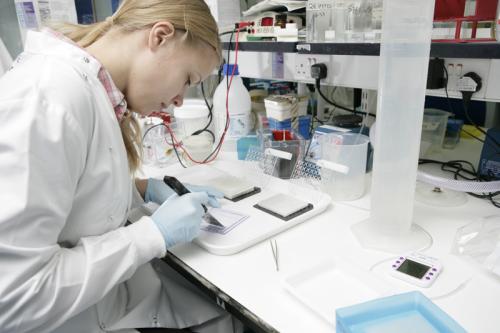
Agne Kazlauskaite sheds new light on Parkin activation by PINK1
Understanding the mechanisms of Parkinson's disease remain a major biomedical challenge since the disease is on the rise and there remain no treatments that can cure or slow it down.
Over the last few years research in the Muqit lab has been focused on understanding how mutations in a previously obscure protein kinase PINK1 (PTEN-induced kinase 1) leads to early-onset Parkinson's disease. Chandana Kondapalli (a former PhD student) made a major advance in this question through her discovery that PINK1 can phosphorylate Parkin at Serine 65 (Ser65) that lies within the N-terminal Ubiquitin-like domain (Ubl) of Parkin.
J. Macdonald Menzies Prize PhD student, Agne Kazlauskaite, (supervised by Miratul Muqit and Dario Alessi) then demonstrated that phosphorylation of Parkin at Ser65 was critical for activation of Parkin E3 ligase activity. Last year Agne made the unexpected finding that PINK1 also phosphorylated ubiquitin at Ser65 and elegantly demonstrated that both PINK1-dependent phosphorylation of Parkin at Ubl Ser65 as well as ubiquitin at Ser65 is required for optimal activation of Parkin E3 ligase activity. Agne was able to publish her findings first ahead of two competing groups – the laboratories of Richard Youle and Noriyuki Matsuda – who independently came to similar conclusions.
However, an outstanding question was how Ser65-phosphorylated ubiquitin (ubiquitinPhospho-Ser65) contributed to Parkin activation? In new work Agne, together with collaborators in the MRC-PPU and Division of Biological Chemistry and Drug Discovery (BCDD) have made fundamental insights that shed light on this question. Agne initially made the exciting discovery that ubiquitinPhospho-Ser65 dramatically increases the rate by which Parkin Ubl Ser65 is phosphorylated by PINK1.
Analysis of the Parkin structure by Daan van Aalten suggested a candidate phosphate-binding pocket via which ubiquitinPhospho-Ser65 might bind Parkin. Through a series of mutagenesis and ubiquitylation experiments Agne was able to determine that two residues, Histidine 302 (His302) and Lysine 151 (Lys151) play a key role in ubiquitinPhospho-Ser65 mediated phosphorylation and activation of Parkin by PINK1.
Next Julio Martinez-Torres and Atul Kumar from Helen Walden's lab and Axel Knebel undertook binding studies to demonstrate that mutation of His302 and Lys151 markedly disrupted binding of ubiquitinPhospho-Ser65 to Parkin suggesting that these residues likely line the ubiquitinPhospho-Ser65 binding pocket. Elegant analysis by Scott Wilkie and Tony Hope from the BCDD demonstrated that binding of ubiquitinPhospho-Ser65 to Parkin disrupts the interaction of the Ubl domain to the C-terminus of Parkin that would be predicted to make the Ubl Ser65 site more accessible to PINK1.
Finally Agne was able to confirm in cells that a Parkin His302 mutant was unable to be maximally phosphorylated at Ubl Ser65 by PINK1 leading to impaired activation of E3 ligase activity suggesting a critical role of ubiquitinPhospho-Ser65 in priming Parkin for phosphorylation and activation at mitochondria.
Agne's new findings provide fundamental mechanistic insights into how PINK1 and phospho-ubiquitin activates Parkin. Her findings will also aid in the development of Parkin activators as a promising class of drugs for treating Parkinson's disease.
To read a copy of Agne's paper published in EMBO Reports click here.
Over the last few years research in the Muqit lab has been focused on understanding how mutations in a previously obscure protein kinase PINK1 (PTEN-induced kinase 1) leads to early-onset Parkinson's disease. Chandana Kondapalli (a former PhD student) made a major advance in this question through her discovery that PINK1 can phosphorylate Parkin at Serine 65 (Ser65) that lies within the N-terminal Ubiquitin-like domain (Ubl) of Parkin.
J. Macdonald Menzies Prize PhD student, Agne Kazlauskaite, (supervised by Miratul Muqit and Dario Alessi) then demonstrated that phosphorylation of Parkin at Ser65 was critical for activation of Parkin E3 ligase activity. Last year Agne made the unexpected finding that PINK1 also phosphorylated ubiquitin at Ser65 and elegantly demonstrated that both PINK1-dependent phosphorylation of Parkin at Ubl Ser65 as well as ubiquitin at Ser65 is required for optimal activation of Parkin E3 ligase activity. Agne was able to publish her findings first ahead of two competing groups – the laboratories of Richard Youle and Noriyuki Matsuda – who independently came to similar conclusions.
However, an outstanding question was how Ser65-phosphorylated ubiquitin (ubiquitinPhospho-Ser65) contributed to Parkin activation? In new work Agne, together with collaborators in the MRC-PPU and Division of Biological Chemistry and Drug Discovery (BCDD) have made fundamental insights that shed light on this question. Agne initially made the exciting discovery that ubiquitinPhospho-Ser65 dramatically increases the rate by which Parkin Ubl Ser65 is phosphorylated by PINK1.
Analysis of the Parkin structure by Daan van Aalten suggested a candidate phosphate-binding pocket via which ubiquitinPhospho-Ser65 might bind Parkin. Through a series of mutagenesis and ubiquitylation experiments Agne was able to determine that two residues, Histidine 302 (His302) and Lysine 151 (Lys151) play a key role in ubiquitinPhospho-Ser65 mediated phosphorylation and activation of Parkin by PINK1.
Next Julio Martinez-Torres and Atul Kumar from Helen Walden's lab and Axel Knebel undertook binding studies to demonstrate that mutation of His302 and Lys151 markedly disrupted binding of ubiquitinPhospho-Ser65 to Parkin suggesting that these residues likely line the ubiquitinPhospho-Ser65 binding pocket. Elegant analysis by Scott Wilkie and Tony Hope from the BCDD demonstrated that binding of ubiquitinPhospho-Ser65 to Parkin disrupts the interaction of the Ubl domain to the C-terminus of Parkin that would be predicted to make the Ubl Ser65 site more accessible to PINK1.
Finally Agne was able to confirm in cells that a Parkin His302 mutant was unable to be maximally phosphorylated at Ubl Ser65 by PINK1 leading to impaired activation of E3 ligase activity suggesting a critical role of ubiquitinPhospho-Ser65 in priming Parkin for phosphorylation and activation at mitochondria.
Agne's new findings provide fundamental mechanistic insights into how PINK1 and phospho-ubiquitin activates Parkin. Her findings will also aid in the development of Parkin activators as a promising class of drugs for treating Parkinson's disease.
To read a copy of Agne's paper published in EMBO Reports click here.

